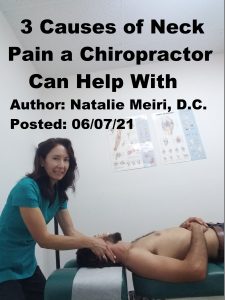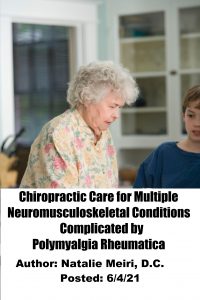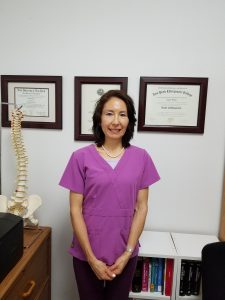
Having your head on top of the neck allows the best view of the surroundings. However, biomechanically, this lever arrangement creates a potentially damaging position for injury events. It forces the head to move quickly into extreme ranges of motion during whiplash for example. In addition to the cervical spine (neck) itself, soft tissue and neural (nerve) structures may be damaged in whiplash injuries. Similarly, in a more insidious manner when a forward head position is maintained for prolonged periods ( i.e. computer), damage occurs as well. So poor ergonomics can lead to postural pain or stiffness. Studies show approximately 80% of people experience neck pain during their lifetime, and 40% deal with it annually. Here are 3 causes of neck pain a chiropractor can help with to learn about:

1. Disc Herniation
The bones (vertebrae) that form the spine in your back are cushioned by small, spongy discs. When these discs are healthy, they act as shock absorbers for the spine and keep the spine flexible. But a damaged disc may rupture, slip or break open causing a herniated disc.
Onset often follows neck injury or it may be insidious (comes on slowly). You often will have had multiple past bouts of neck pain following minor injuries. Nerve root irritation may occur as a result of disc herniation. And this nerve root branches away from the spinal cord to your arm. Therefore, this may cause pain that radiates into the shoulder and/or arm. Furthermore, it may cause hand weakness.
2. Burner/Stinger
“Burner” or “stinger” are the names given to injury of the brachial plexus (network of nerves in the shoulder that carries movement and sensory signals from the spinal cord to the arms and hands) or nerve roots (initial segment of a nerve leaving spinal cord). This injury is caused by a lateral flexion (moving your head toward one of your shoulders) injury. In general, the injury is a lateral flexion of the head away from the involved side with accompanying shoulder distraction (depression) on the involved side.
You may have a sudden onset of burning pain and/or numbness along the lateral (side) arm with associated arm weakness following a lateral flexion injury of the neck (e.g., lateral “whiplash”). The symptoms of burning usually last only a couple of minutes. So while burners/stingers are typically transient (lasting a short time), you may continue to have neck and arm pain or weakness afterwards. This is a common injury in sports and often recur leading to further disability. It is a common injury in football hockey, wrestling, lacrosse, and diving.

3. Thoracic Outlet Syndrome (TOS)
The brachial plexus and/or subclavian/axillary arteries (arteries in the thorax) can be compressed at various sites as they travel downward into the arm. Several compression sites are possible causing TOS.
Firstly, there are scalene muscles (group of three pairs of muscles in side of the neck), and the costoclavicular area (area of collar bone and 1st rib). Secondly, there can be compression between the coracoid (short projection from the shoulder blade) and the pectoralis minor (triangular muscle, situated at the upper part of the chest). Lastly, you could have an elongated C7 transverse process (cervical/neck rib) which is rare. Only 1% of the population has cervical ribs, and only 10% of those individuals have symptoms.
Muscular compression at the scalenes or with the pectoralis minor, is believed to be due to tight muscles and/or posturally induced (forward head and rounded shoulder habit). Also, a traumatic injury can trigger TOS.
You will have diffuse arm symptoms, including numbness and tingling. Often there is a path down the inside of your arm to the little and ring fingers. Overhead activity often makes this worse.
3 causes of neck pain a chiropractor can help with: Recover from it naturally!
Getting regular chiropractic care from a West Palm Beach neck pain chiropractor can help relieve pain naturally from an already existing injury, or even offer injury prevention. Chiropractic is a holistic and natural way to not only treat existing injuries, but to keep your body in its best working condition.
Contact Meiri Chiropractic today on the 3 causes of neck pain a chiropractor can help with or/and other ailments.
Meiri Chiropractic
561-253-8984


